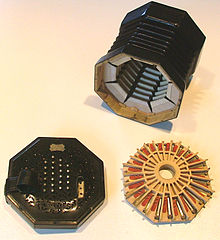User:Jeanx58/六角手风琴
六角手风琴与各类其他手风琴及口琴类似,是簧片类乐器。它有风箱,琴键钮通常在琴身两侧。演奏时触压键钮,使其与风箱同向运动,而一般手风琴,按键方向与风向运动方向垂直。
六角手风琴很可能是各自独立地在英格兰和德国地发展起来的。英格兰六角手风琴由查尔斯·惠斯通爵士发明于1829年。卡尔·弗里德里希·尤利格则于1834年公布了德国六角琴。在古典音乐、爱尔兰、英格兰和南非的传统音乐以及探戈和波尔卡音乐中多有使用。
体系
[编辑]六角手风琴这一名称涉及一类手持的,风箱驱动的簧片乐器。它们的体系会有不同,主要区别在于键盘安排以及在风箱推与拉时按键发出同一音符(单音)还是不同的音符(双音)。
由于六角手风琴几乎同时出现在英格兰和德国,六角琴的体系可大致分为英格兰、盎格鲁-日耳曼和日耳曼三个类型。对于掌握一种体系的乐手,对另外一个体系可能完全不明就里。
英格兰六角手风琴和双重奏六角手风琴
[编辑]
英格兰六角手风琴和双重奏六角手风琴在历史上和琴的结构上都有类似之处。二者均使用半音音阶以及单音体系,即在风箱推拉时发出同一音符。这两种在英格兰发展的乐器尺寸都小于日尔曼六角手风琴,通常呈六角形,也有八角、十角甚至十二角的。英格兰体系让音符分布于琴的两侧,容易演奏快节奏曲调。双重奏体系将低音部分置于左侧,高音部分置于右侧,以便演奏交错的和声和曲调。
英格兰六角手风琴是查尔斯·惠斯通爵士发明的,他于1829年在大不列颠获得专利。惠斯通在1844年也获得双重奏六角手风琴的专利。
盎格鲁六角手风琴
[编辑]
The Anglo or Anglo-German concertina is, historically, a hybrid between the English and German concertinas. The button layouts are generally the same as the original 20-button German concertinas designed by Uhlig in 1834, and in a bisonoric system. Within a few years of its invention, the German concertina was a popular import in England, Ireland, and North America, due to its ease of use and relatively low price. English manufacturers responded to this popularity by offering their own versions using traditional English methods: concertina reeds instead of long-plate reeds, independent pivots for each button, and hexagon-shaped ends, resulting in the modern Anglo concertina.
References
[编辑]- ^ Giacomo Meyerbeer. The Diaries of Giacomo Meyerbeer: The years of celebrity, 1850-1856. Fairleigh Dickinson Univ Press. 1 January 2002: 138–. ISBN 978-0-8386-3844-6.
[[Category:手風琴]] [[Category:英格兰发明]] [[Category:德国发明]]
